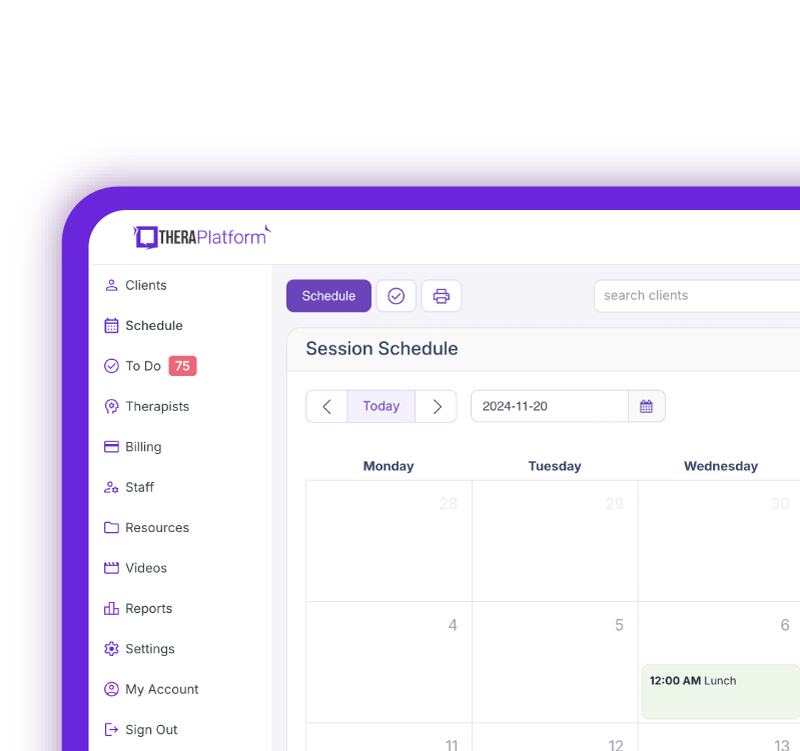Teletherapy technology

A teletherapy technology checklist for therapists is a great guideline for establishing your private practice if you’re considering expanding into providing teletherapy. Providers interested in teletherapy often wonder what equipment, technology, documents, therapeutic materials and marketing are needed to provide teletherapy. TheraPlatform has created this handy teletherapy checklist, outlining all you need to get started with teletherapy.
→ Download My Free Teletherapy Resources
Summary
- A reliable PC or Mac, high-resolution webcam, clear audio microphone, and strong internet connection are essential teletherapy technology components. Secure, HIPAA-compliant platforms like TheraPlatform help streamline video sessions, documentation, and billing.
- Therapists must have the right licensing, malpractice insurance, telehealth consent forms, HIPAA privacy policies, and intake documents to protect both their practice and clients. Many EMRs offer built-in forms to simplify this process.
- Digital worksheets, apps, online resources, YouTube videos, and physical stimuli (using a document camera) are advanced teletherapy technology that can keep sessions engaging and effective across different client needs.
- A professional website, social media presence, referral networking, and educational content (blogs, flyers, handouts) help therapists establish credibility and grow their teletherapy practice.
Streamline your practice with One EHR
- Scheduling
- Flexible notes
- Template library
- Billing & payments
- Insurance claims
- Client portal
- Telehealth
- E-fax

Equipment and technology for teletherapy technology
For a professional and effective teletherapy experience, therapists need reliable teletherapy technology and secure platforms. Below is a list of the equipment needed to ensure privacy and security as well as a safe environment for your clients for your teletherapy sessions.
- Computer (PC or Mac) for teletherapy sessions: A reliable laptop or desktop computer capable of running teletherapy platforms effectively, ensuring a professional and seamless virtual experience for both you and your therapy clients.
- Built-in or external camera for high-quality video: A clear, high-resolution webcam helps maintain strong client engagement and build rapport during virtual therapy sessions.
- Built-in or external microphone for clear audio: A quality microphone is a teletherapy technology must-have and ensures clients can hear you clearly, reduces background noise and improves communication in online sessions.
- Document camera (if using physical stimuli in sessions): A specialized camera that allows you to show worksheets, books, or other physical materials in real time. This may be useful for child therapy, assessments, or interactive exercises. Some more advanced EHRs like TheraPlatform have tools such as whiteboards for resource sharing.
- Noise-canceling headphones with built-in microphone: A headset that enhances privacy and minimizes background noise, creating a distraction-free environment for teletherapy sessions.
- High-speed internet (Minimum: 3Mbps download and Upload, Ping: 25ms): A strong internet connection is essential to prevent lags or dropped calls, ensuring a smooth and professional teletherapy experience.
- Wired internet connection (if office is located far from the router): An Ethernet cable provides a more stable connection than Wi-Fi, reducing the risk of connectivity issues during therapy sessions.
- Credit card processing for session payments: An integrated payment solution that allows clients to pay for sessions online, reducing no-shows and improving cash flow for your practice.
- HIPAA-compliant video conferencing platform (e.g., TheraPlatform): A secure, HIPAA-compliant telehealth platform designed for therapists, ensures confidential and legally protected virtual sessions with clients and is a non-negotiable teletherapy technology tool. Some include EMR and practice management software that simplifies scheduling, client documentation, and insurance billing—helping you run your private practice more efficiently and reduce administrative burden.
Practice Management + EHR + Telehealth
Mange more in less time in your practice with TheraPlatform

.
Documents and paperwork for teletherapy technology
Once you have your equipment covered, you’ll need to file or review and file the legal, ethical, and administrative paperwork to ensure compliance and protect both their practice and clients.
- License in clients’ state(s): Therapists must be licensed in the state(s) where their clients reside to legally provide teletherapy. Some states offer reciprocity or temporary telehealth permissions.
- Malpractice insurance (Professional Liability Insurance with Teletherapy Coverage, e.g., CPH & Associates): Coverage that protects therapists from legal claims related to professional services. Ensure your policy includes teletherapy coverage to stay compliant and protected.
- Consent form for telehealth (Teletherapy) (e.g., Built-in consent forms in TheraPlatform): A required document that informs clients about the risks, benefits, and limitations of teletherapy. Many EMR platforms, like TheraPlatform, include customizable consent forms.
- Payment policy: A clear policy outlining session fees, payment methods, and billing procedures, including late fees and insurance reimbursement details, to prevent misunderstandings with clients.
- HIPAA privacy form: A required document that explains how client information is protected, their rights under HIPAA, and how their data may be used or shared.
- Cancellation and no-show policy: A policy that sets clear expectations regarding cancellations, rescheduling, and fees for missed appointments, helping reduce last-minute cancellations and no-shows.
- Intake forms (e.g., Built-in Forms in TheraPlatform): Forms that collect essential client information, including demographics, medical history, presenting concerns, and emergency contacts. Many EMRs offer pre-built, customizable intake forms.
Watch this video to find out more about launching teletherapy in your practice
Sign up for My Free Teletherapy E-Course
Therapeutic materials for teletherapy
To deliver effective teletherapy, therapists need compelling digital and physical resources that engage clients and support therapeutic goals.
Think worksheets and apps that help engage your client, potentially leading to excellent treatment outcomes.
- Digital worksheets and handouts (organize your own in TheraPlatform) Interactive or printable resources used for client education, skill-building, and therapeutic exercises. Many EMRs allow therapists to store and organize these materials for easy access.
- Apps (TheraPlatform is the only video, EMR platform with built-In apps that are interactive on both the clinician’s and client’s end): Interactive tools that enhance teletherapy sessions, such as emotion regulation activities, cognitive exercises, and communication games, improving engagement and outcomes.
- Online resources (e.g., Teachers Pay Teachers, Educational Online Games, and Websites): Websites offering therapy-related activities, worksheets, and games that can be used to support interventions for children, teens, and adults.
- YouTube videos (Watch them simultaneously with clients in TheraPlatform): A feature allowing therapists to stream YouTube videos during sessions to illustrate concepts, model skills, or facilitate discussions in a shared viewing experience and a teletherapy technology plus.
- Physical stimuli (e.g., Flashcards, Books, etc., Used with a Document Camera): Physical materials that can be displayed using a document camera to replicate in-person therapy activities, such as guided reading, language exercises, or cognitive tasks.
Marketing for teletherapy
Ready to tell the world about your newly launched teletherapy private practice? To attract and retain clients, you’ll need a strong online presence.
Here’s a few ideas on where to start.
- Website: A professional website is essential for attracting clients and showcasing your teletherapy services. Some platforms offer therapist-specific website design, SEO optimization, and built-in scheduling options.
- Business cards (Mention teletherapy services): Business cards remain a valuable networking tool. Be sure to include your teletherapy offerings, website, and contact information so potential clients and referral sources can easily reach you.
- Flyers about teletherapy: Create simple, informative flyers explaining the benefits of teletherapy, how it works, and who it’s for. These can be shared with local businesses, doctors’ offices, and community centers.
- Handouts for clients: Provide educational materials on topics like how to prepare for a teletherapy session, telehealth privacy and security, and mental health resources. These can be sent via email or included in intake packets.
- Blog: A blog can help position you as an expert while improving your website’s search engine ranking. Write about topics relevant to your ideal clients, such as managing anxiety remotely, the benefits of teletherapy, or self-care strategies.
- Social media presence: Use platforms like YouTube, Instagram, Facebook, and LinkedIn to promote your services, share mental health tips, and engage with potential clients. A strong online presence helps build trust and expand your reach.
- Building referral sources: Establish relationships with doctors, schools, community organizations, and other therapists who may refer clients to your teletherapy practice. Networking, online directories, and professional groups can help generate referrals.
Preparation in using teletherapy technology is key when it comes to launching a private teletherapy practice. Make sure you have top-notch equipment, all of the business and legal paperwork filed and then start building your client base through marketing. Teletherapy offers clients flexibility when it comes to attending their sessions and provides therapists with a potentially larger client base to work with.
Streamline your practice with One EHR
- Scheduling
- Flexible notes
- Template library
- Billing & payments
- Insurance claims
- Client portal
- Telehealth
- E-fax

Resources
TheraPlatform is an all-in-one EHR, practice management, and teletherapy software built for therapists to help them save time on admin tasks. It offers a 30-day risk-free trial with no credit card required and supports mental and behavioral health, SLPs, OTs, and PTs in group and solo practices.
More resources
- Therapy resources and worksheets
- Therapy private practice courses
- Ultimate teletherapy ebook
- The Ultimate Insurance Billing Guide for Therapists
- The Ultimate Guide to Starting a Private Therapy Practice
- Mental health credentialing
- Insurance billing 101
- Practice management tools
- Behavioral Health tools



